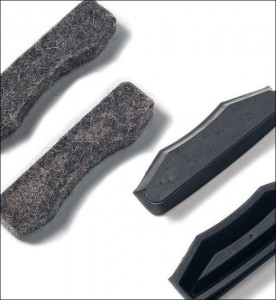 In an enclosed doctor blade chamber system, the job of the end seals is to keep the coating or ink from leaking out of the ends of the chamber. Selecting the right end seals for your application is critical to achieve proper doctor blade seating and prevent leaks. If used correctly, these inexpensive consumables will ensure graphic quality and save a printer thousands of dollars in waste, downtime and replacement of other press parts due to premature wear.
In an enclosed doctor blade chamber system, the job of the end seals is to keep the coating or ink from leaking out of the ends of the chamber. Selecting the right end seals for your application is critical to achieve proper doctor blade seating and prevent leaks. If used correctly, these inexpensive consumables will ensure graphic quality and save a printer thousands of dollars in waste, downtime and replacement of other press parts due to premature wear.
Problems That Result from Failed End Seals
- Chamber leaks and mess
- Poor graphic quality and ink/coating waste
- Excessive doctor blade wear
- Premature anilox roller wear and scoring
- Press downtime
Why Chamber Leaks Occur
While there are other causes of chamber leaks, failed end seals are responsible for the lion’s share. It is important to use an end seal material that is compatible with the type of ink or coating being used, the length of the run and the press speed. Good seal design for a proper fit is also critical to ensure that end seals contain the liquid within the confines of the chamber. Incorrect end seal size and shape will leave gaps for fluid to leak out of the ends. If the seals aren’t sufficiently lubricated, the increased friction against the anilox roller will cause buildup and leaking. Enlist the help of your end seal supplier to work through these issues and make sure that you are using the correct end seals for your application.
When a chamber is leaking, a press operator will often try to fix the problem by increasing the load pressure instead of looking for the cause of the leak. End seal leaks should never be resolved by increasing chamber pressure. The additional pressure increases friction between the doctor blade and the anilox roll and causes both to wear prematurely. Paying a little extra attention when installing doctor blades and end seals can prevent many leaks from occurring in the first place. After installing new end seals, a press operator should evaluate the chamber and confirm that there is a snug end seal fit with no gaps or distortion. The doctor blade should have some upward pressure to form an adequate seal, but not so much that it requires extra loading pressure to make contact with the anilox roller in the middle of the blade.
End Seal Materials for Chamber Systems
There are various end seal materials which range in abrasion resistance, durability and solvent resistance. Again, your end seal supplier is a good resource to help you determine the best material for your application:
-
- Foam seals are the most common and the least expensive type of end seals. This material generally does not perform as well as other materials and may not be a good choice for long runs, higher press speeds and certain fluid chemistries. There can also be a lot of variation in the density of the material which can range from super firm to more malleable.
-
- Neoprene or rubber seals offer longer life compared to foam seals. They are compatible with aqueous and UV coatings & inks so they don’t have to be changed out between jobs. However, these seals do not seat well due to the coefficient of friction between the material and the anilox roller surface.
- Pre-soaked felt end seals are a superior solution for resolving leaks. These end seals are oversized for a snug fit and pre-soaked in petroleum to reduce friction and prevent buildup. Felt end seals are compatible with all ink and coating types, provide a tighter seal and typically last longer than rubber and foam seals. Keeping felt seals lubricated with seal grease is key to their superior performance and longer life. Felt end seals tend to dry out after the anilox system is flushed with detergents and water. Applying seal grease to the radius portion of the seals after flushing the system will ensure a tight fit and extend the life of the seals by reducing friction.
Choosing the right seal material and design for your application and replacing end seals when necessary will help ensure that they do their job of keeping inks and coatings from leaking out of the chamber. Better yet, the right seals will allow for proper doctor blade seating and a predictable and even transfer of fluid from the anilox roller to the blanket. Despite their small cost, end seals have the power to save thousands of dollars in waste and downtime.
